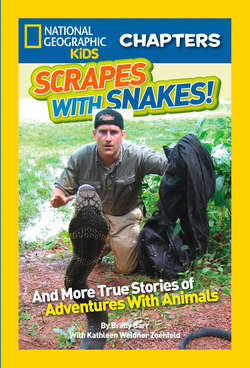Читать книгу National Geographic Kids Chapters: Scrapes With Snakes: True Stories of Adventures With Animals - Brady Barr - Страница 7
Оглавление
Indian rock pythons can grow to more than 20 feet (6 m) long.
They are incredibly strong. A python has more than 10,000 muscles (sounds like MUH-sels) in its body. Humans have fewer than 1,000. Pythons are constrictors (sounds like kun-STRICT-ers). That means they use their muscles to squeeze, or constrict, their prey.
When a python sees an animal it wants to eat, it strikes out with lightning speed. It latches on to it with needle-sharp teeth. The teeth curve backward, toward the snake’s throat. Once an animal is caught in those teeth, it cannot pull away. The snake instantly coils around it and squeezes. When the prey has died, the python opens its mouth wide and swallows it whole.
A snake big enough to swallow a cow could certainly swallow a man! With this thought in my head, I waded into the dark water. I had never seen a truly giant snake in the wild before. But I knew it would be better to find it before it found me. I did not want to experience a python’s big squeeze.
Gerry and I searched for a long time without seeing anything. Then we decided it might be better if we split up. That way we could search more ground—or swamp, that is. Pretty soon, I heard Gerry shouting, “Snake! Snake! Snake!” I nearly jumped out of my skin.
I slogged toward Gerry through the knee-deep water. Peering through the tall grass, I could see he had a small, three-foot (1-m)-long python in his grasp. This was very cool. But I was expecting something a little larger. This couldn’t be the cow-eater, that’s for sure. We split up again and kept searching. After several hours, all we’d found were three more small pythons.
Exhausted, we sat on the riverbank and picked the leeches off our bare legs. After all our effort, we had found only four small snakes. We felt frustrated.
(photo credit 2.1)
A snake smells with its nose, like humans do.
But a snake has another secret weapon in the world of smell—its forked tongue. A snake flicks its tongue in the air. The two tips pick up tiny particles of odor. When the snake pulls its tongue in, the odor particles are delivered to a special organ on the roof of its mouth, called the Jacobson’s organ. This helps the snake identify the odors. Together, the nose and Jacobson’s organ make the snake a super smeller!
We wanted to get back to the croc study we’d come to India for in the first place. We were both thinking this giant snake story was simply that: a tall tale! We had about decided to call it quits, when a small boy, about ten years old, came up to us. His name was Ramkrishna (sounds like ram-KRISH-nah). He had been watching us all day. He said that he really liked snakes. And he told us we were looking for the snake in the wrong spot.
Ramkrishna said the big snake liked to hang out in another part of the swamp, in an area farther from the river. Gerry wasn’t so sure. He still felt we’d find the snake closer to the river. He said he was going to take one more look.
I decided to check out the area Ramkrishna told us about. So, Gerry and I separated again for one last slog through the muck. We agreed to meet up at our truck before sunset.
By now, I was pretty sure there was no giant cow-eating snake. I was feeling a lot more relaxed in the swamp. But I was not crazy about the leeches! I was trudging along, wondering if any of those slimy little things were crawling on me again. I reached down to scratch my leg. And when I looked up, there it was! I froze in disbelief. I was horrified and fascinated at the same time. Never in my life had I seen a snake so big!
Ramkrishna had been right. Farther from the river, the snake had found a nice spot to come out of the water. Here it could warm up in the sunshine. But it could slide back into the water quickly, if it needed to.
At first, I thought maybe the snake was asleep in the warm sun. But there’s no way to know for sure if a snake is asleep. Snakes don’t have eyelids, so their eyes are always open.
Did You Know?
Like sharks and crocodiles, snakes lose teeth and grow in new ones throughout their lives.
I watched for any little movement. Suddenly, I saw the snake’s long forked tongue flick out. It waved around in the air in long, drawn-out motions.
Uh oh! I thought. It knows I’m here! Snakes use their forked tongues to pick up odors. And right now that giant was smelling me.
After a long battle, Gerry and I posed with our prize. I always release the snakes I catch back into the wild.
